Attached files
| file | filename |
|---|---|
| EX-99.1 - EX-99.1 - Cerence Inc. | crnc-ex991_6.htm |
| 8-K - 8-K - Cerence Inc. | crnc-8k_20201116.htm |
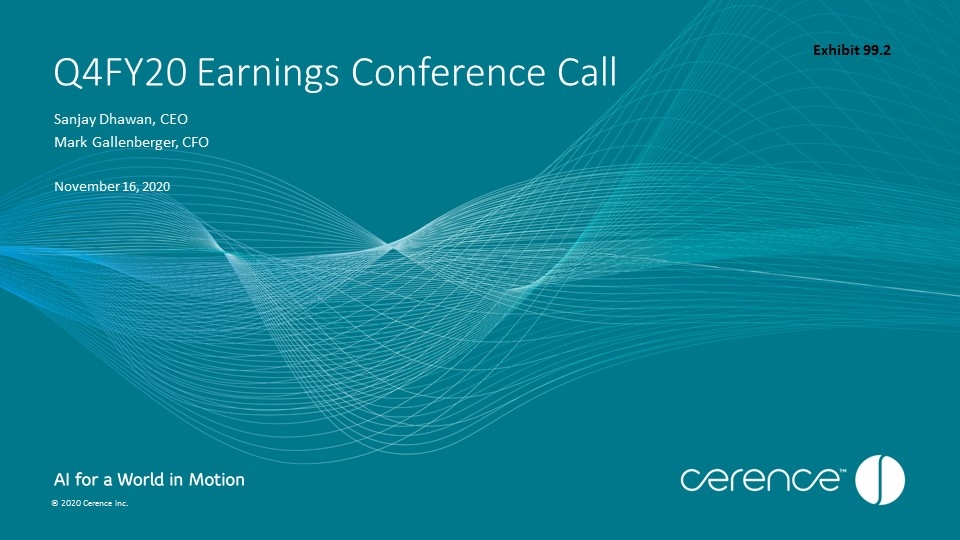
Q4FY20 Earnings Conference Call Sanjay Dhawan, CEO Mark Gallenberger, CFO November 16, 2020 Exhibit 99.2
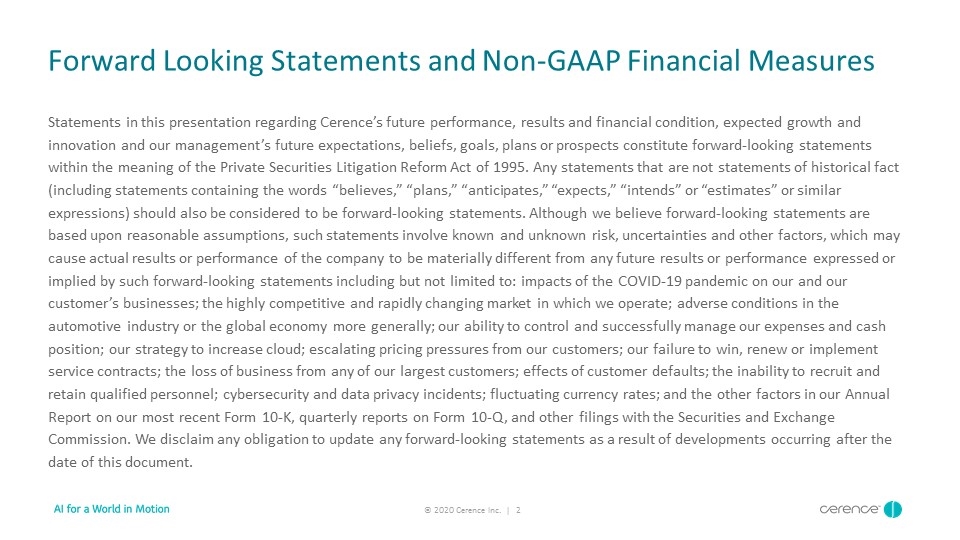
Forward Looking Statements and Non-GAAP Financial Measures Statements in this presentation regarding Cerence’s future performance, results and financial condition, expected growth and innovation and our management’s future expectations, beliefs, goals, plans or prospects constitute forward-looking statements within the meaning of the Private Securities Litigation Reform Act of 1995. Any statements that are not statements of historical fact (including statements containing the words “believes,” “plans,” “anticipates,” “expects,” “intends” or “estimates” or similar expressions) should also be considered to be forward-looking statements. Although we believe forward-looking statements are based upon reasonable assumptions, such statements involve known and unknown risk, uncertainties and other factors, which may cause actual results or performance of the company to be materially different from any future results or performance expressed or implied by such forward-looking statements including but not limited to: impacts of the COVID-19 pandemic on our and our customer’s businesses; the highly competitive and rapidly changing market in which we operate; adverse conditions in the automotive industry or the global economy more generally; our ability to control and successfully manage our expenses and cash position; our strategy to increase cloud; escalating pricing pressures from our customers; our failure to win, renew or implement service contracts; the loss of business from any of our largest customers; effects of customer defaults; the inability to recruit and retain qualified personnel; cybersecurity and data privacy incidents; fluctuating currency rates; and the other factors in our Annual Report on our most recent Form 10-K, quarterly reports on Form 10-Q, and other filings with the Securities and Exchange Commission. We disclaim any obligation to update any forward-looking statements as a result of developments occurring after the date of this document.
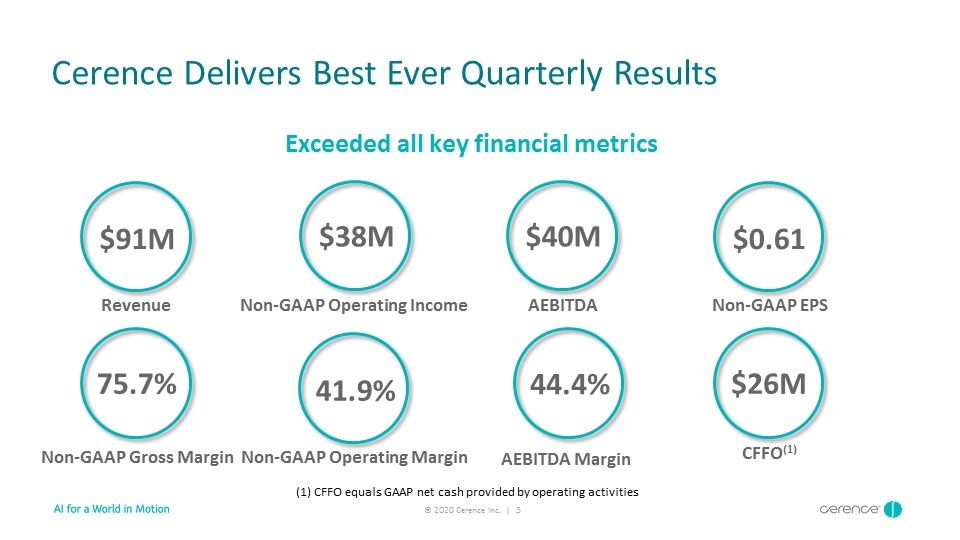
Cerence Delivers Best Ever Quarterly Results Exceeded all key financial metrics $91M 41.9% $0.61 75.7% $38M $26M Revenue Non-GAAP Gross Margin Non-GAAP Operating Margin Non-GAAP Operating Income Non-GAAP EPS CFFO(1) 3 44.4% AEBITDA Margin $40M AEBITDA (1) CFFO equals GAAP net cash provided by operating activities
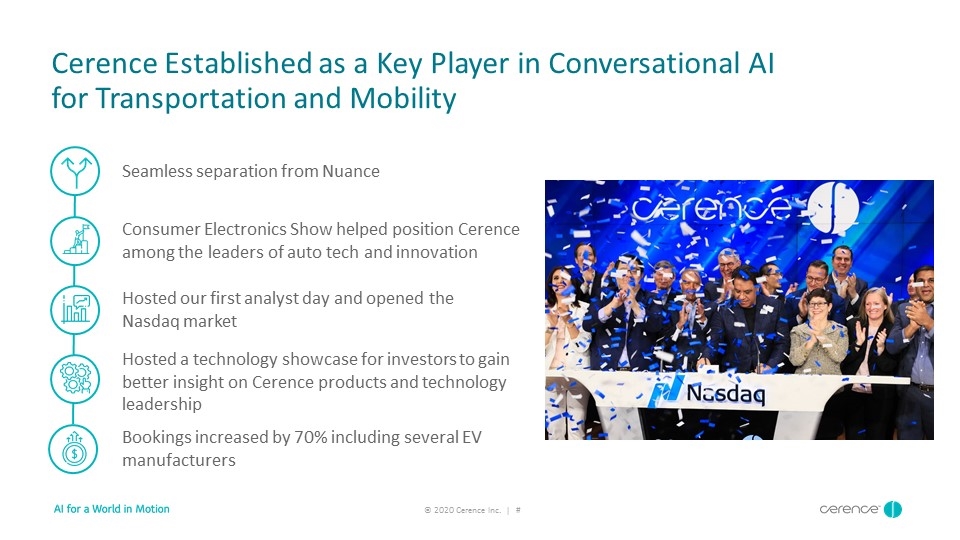
Cerence Established as a Key Player in Conversational AI for Transportation and Mobility # Seamless separation from Nuance Consumer Electronics Show helped position Cerence among the leaders of auto tech and innovation Hosted our first analyst day and opened the Nasdaq market Hosted a technology showcase for investors to gain better insight on Cerence products and technology leadership Bookings increased by 70% including several EV manufacturers
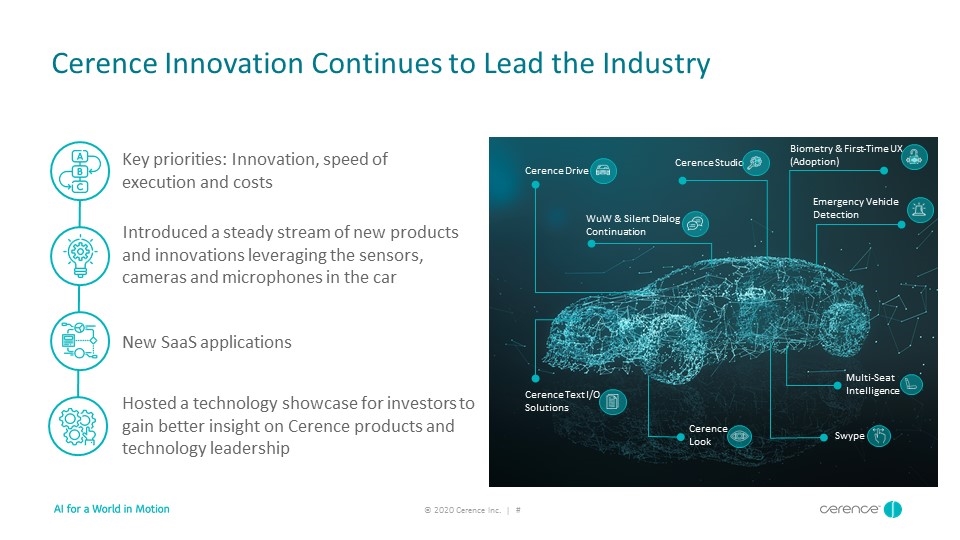
Cerence Innovation Continues to Lead the Industry # Key priorities: Innovation, speed of execution and costs Introduced a steady stream of new products and innovations leveraging the sensors, cameras and microphones in the car New SaaS applications Hosted a technology showcase for investors to gain better insight on Cerence products and technology leadership Cerence Drive Biometry & First-Time UX (Adoption) Cerence Studio Emergency Vehicle Detection WuW & Silent Dialog Continuation Cerence Text I/O Solutions Cerence Look Multi-Seat Intelligence Swype
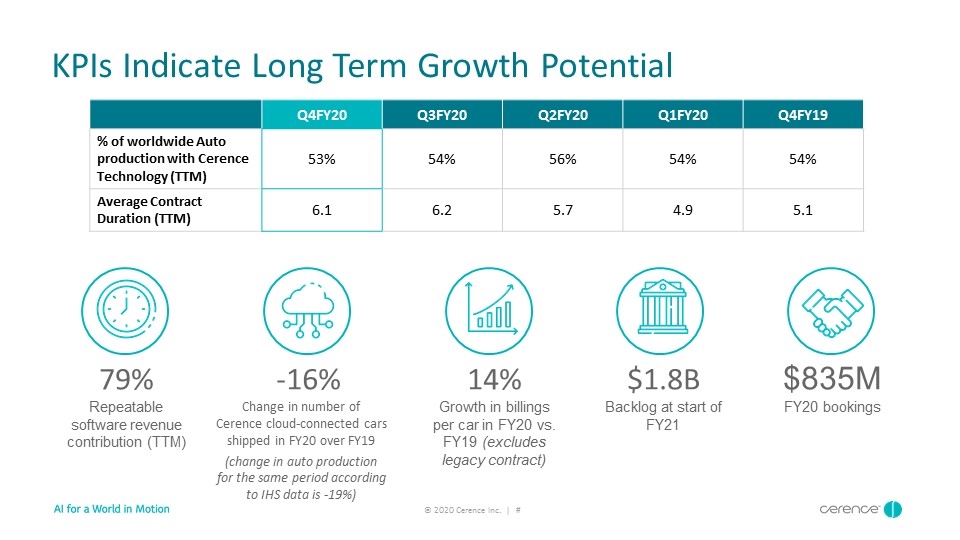
KPIs Indicate Long Term Growth Potential # Q4FY20 Q3FY20 Q2FY20 Q1FY20 Q4FY19 % of worldwide Auto production with Cerence Technology (TTM) 53% 54% 56% 54% 54% Average Contract Duration (TTM) 6.1 6.2 5.7 4.9 5.1 79% Repeatable software revenue contribution (TTM) -16% Change in number of Cerence cloud-connected cars shipped in FY20 over FY19 (change in auto production for the same period according to IHS data is -19%) 14% Growth in billings per car in FY20 vs. FY19 (excludes legacy contract) $1.8B Backlog at start of FY21 $835M FY20 bookings
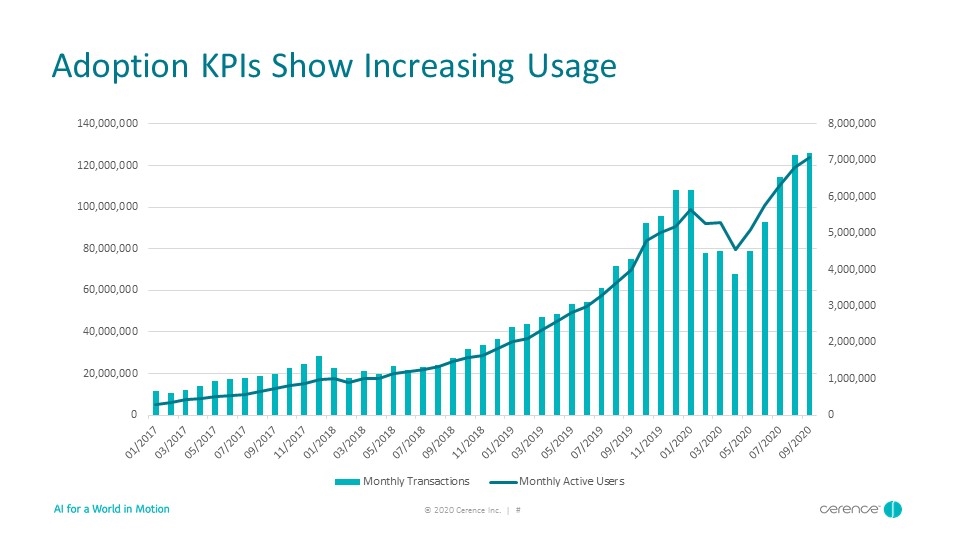
Adoption KPIs Show Increasing Usage #
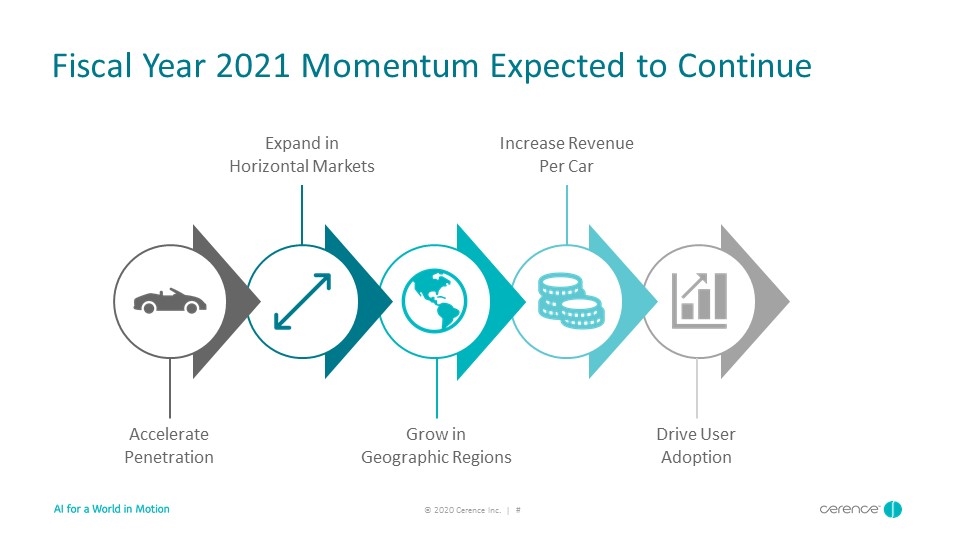
Fiscal Year 2021 Momentum Expected to Continue # Accelerate Penetration Expand in Horizontal Markets Grow in Geographic Regions Increase Revenue Per Car Drive User Adoption
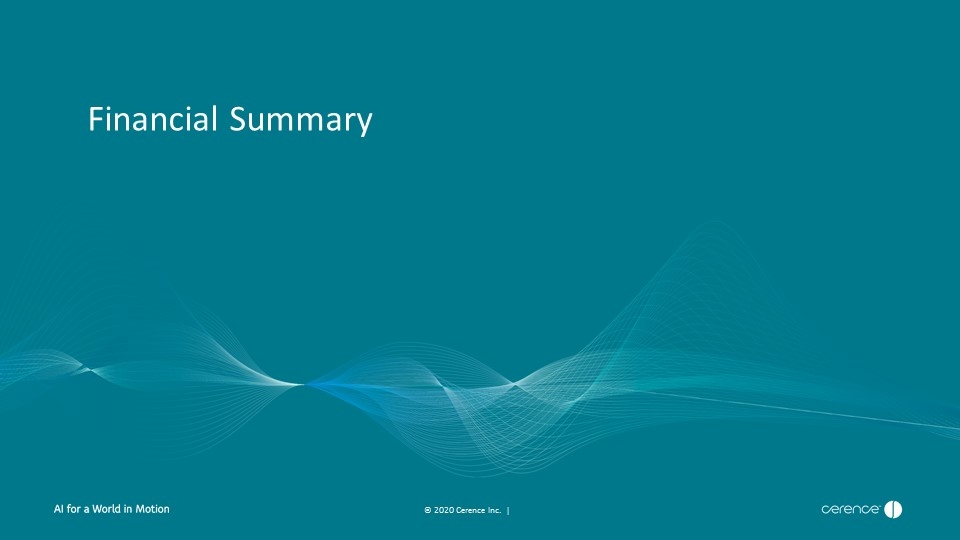
Financial Summary
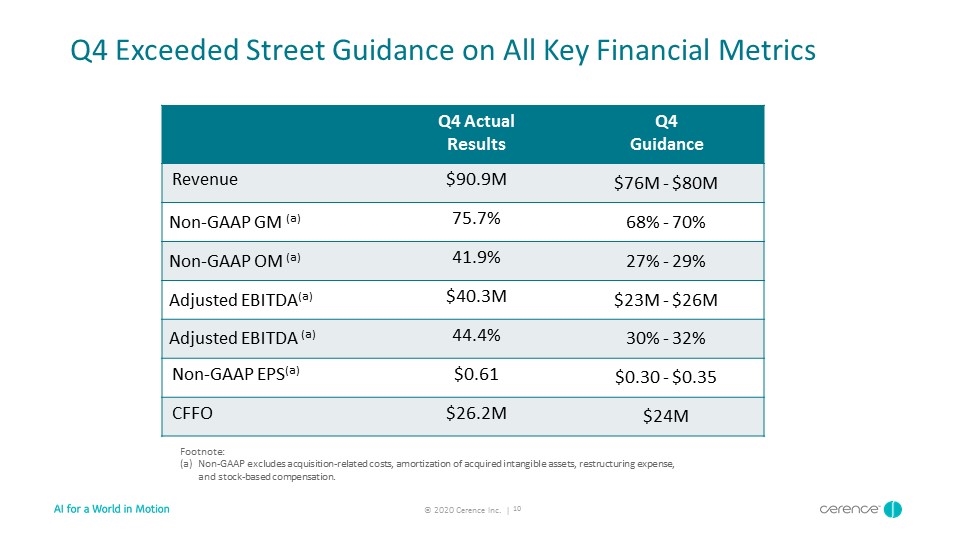
Q4 Exceeded Street Guidance on All Key Financial Metrics Q4 Actual Results Q4 Guidance Revenue $90.9M $76M - $80M Non-GAAP GM (a) 75.7% 68% - 70% Non-GAAP OM (a) 41.9% 27% - 29% Adjusted EBITDA(a) $40.3M $23M - $26M Adjusted EBITDA (a) 44.4% 30% - 32% Non-GAAP EPS(a) $0.61 $0.30 - $0.35 CFFO $26.2M $24M Footnote: Non-GAAP excludes acquisition-related costs, amortization of acquired intangible assets, restructuring expense, and stock-based compensation.
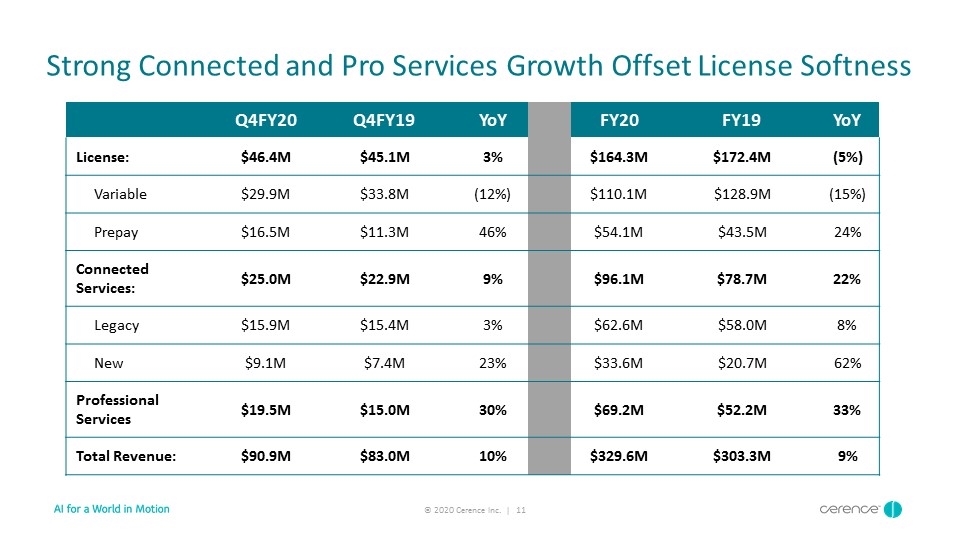
Strong Connected and Pro Services Growth Offset License Softness Q4FY20 Q4FY19 YoY FY20 FY19 YoY License: $46.4M $45.1M 3% $164.3M $172.4M (5%) Variable $29.9M $33.8M (12%) $110.1M $128.9M (15%) Prepay $16.5M $11.3M 46% $54.1M $43.5M 24% Connected Services: $25.0M $22.9M 9% $96.1M $78.7M 22% Legacy $15.9M $15.4M 3% $62.6M $58.0M 8% New $9.1M $7.4M 23% $33.6M $20.7M 62% Professional Services $19.5M $15.0M 30% $69.2M $52.2M 33% Total Revenue: $90.9M $83.0M 10% $329.6M $303.3M 9%
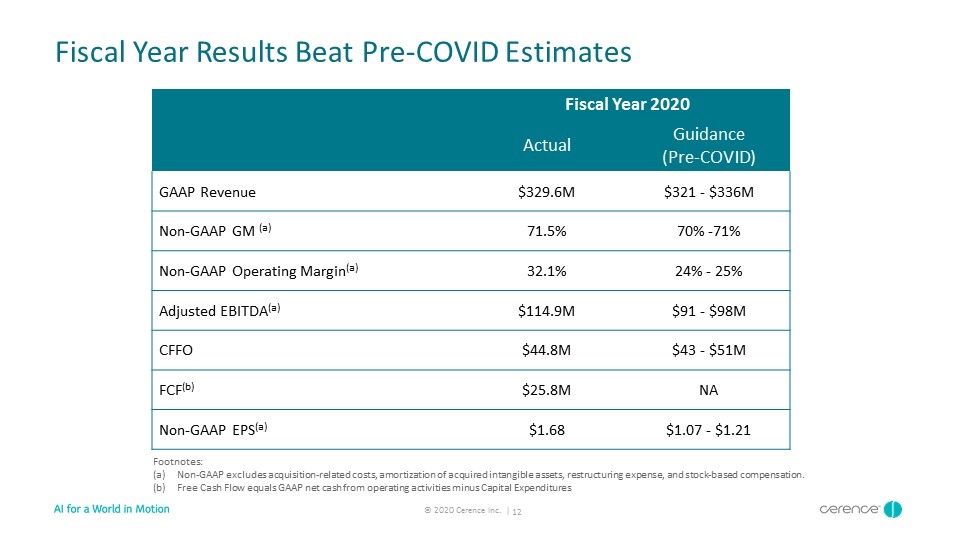
Fiscal Year Results Beat Pre-COVID Estimates Fiscal Year 2020 Actual Guidance (Pre-COVID) GAAP Revenue $329.6M $321 - $336M Non-GAAP GM (a) 71.5% 70% -71% Non-GAAP Operating Margin(a) 32.1% 24% - 25% Adjusted EBITDA(a) $114.9M $91 - $98M CFFO $44.8M $43 - $51M FCF(b) $25.8M NA Non-GAAP EPS(a) $1.68 $1.07 - $1.21 Footnotes: Non-GAAP excludes acquisition-related costs, amortization of acquired intangible assets, restructuring expense, and stock-based compensation. Free Cash Flow equals GAAP net cash from operating activities minus Capital Expenditures
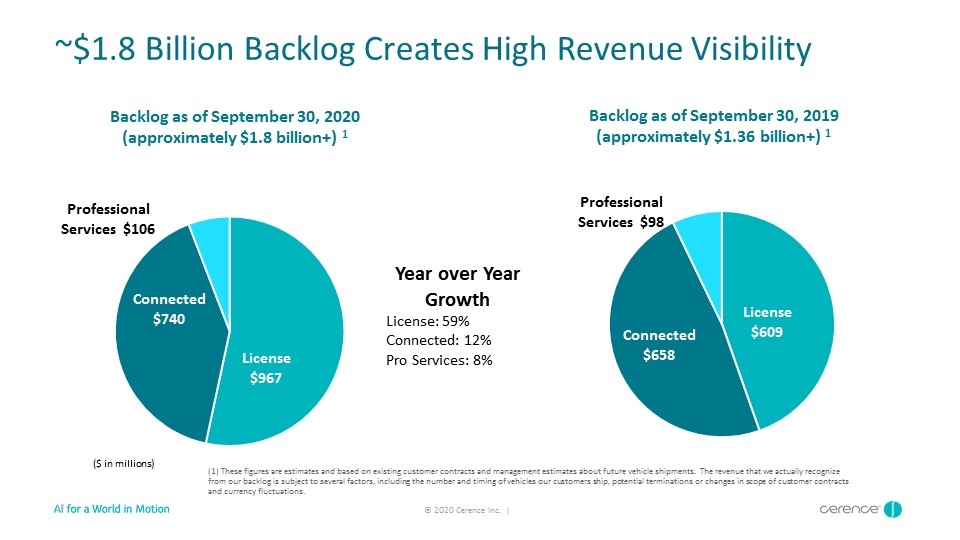
~$1.8 Billion Backlog Creates High Revenue Visibility ($ in millions) Backlog as of September 30, 2019 (approximately $1.36 billion+) 1 (1) These figures are estimates and based on existing customer contracts and management estimates about future vehicle shipments. The revenue that we actually recognize from our backlog is subject to several factors, including the number and timing of vehicles our customers ship, potential terminations or changes in scope of customer contracts and currency fluctuations. Backlog as of September 30, 2020 (approximately $1.8 billion+) 1 Year over Year Growth License: 59% Connected: 12% Pro Services: 8%
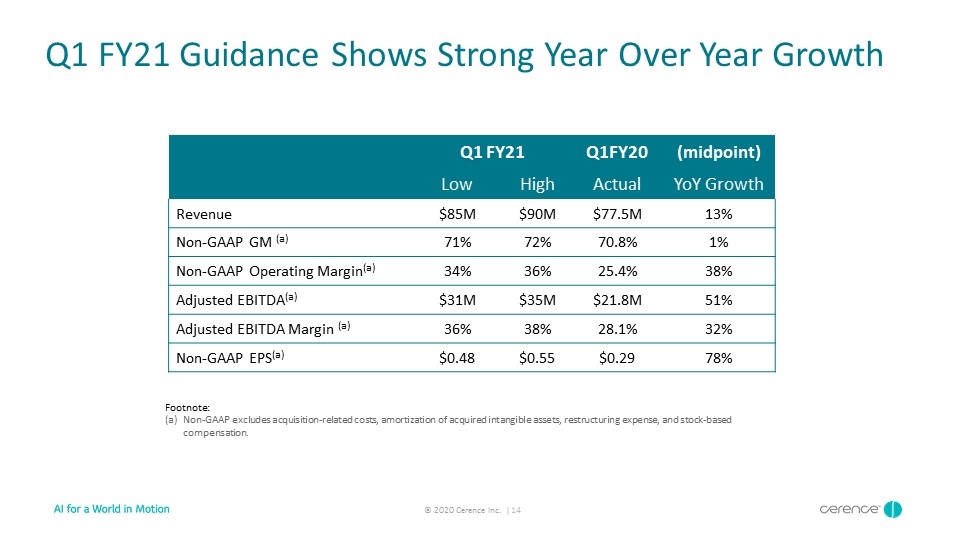
Q1 FY21 Guidance Shows Strong Year Over Year Growth Footnote: Non-GAAP excludes acquisition-related costs, amortization of acquired intangible assets, restructuring expense, and stock-based compensation. Q1 FY21 Q1FY20 (midpoint) Low High Actual YoY Growth Revenue $85M $90M $77.5M 13% Non-GAAP GM (a) 71% 72% 70.8% 1% Non-GAAP Operating Margin(a) 34% 36% 25.4% 38% Adjusted EBITDA(a) $31M $35M $21.8M 51% Adjusted EBITDA Margin (a) 36% 38% 28.1% 32% Non-GAAP EPS(a) $0.48 $0.55 $0.29 78%
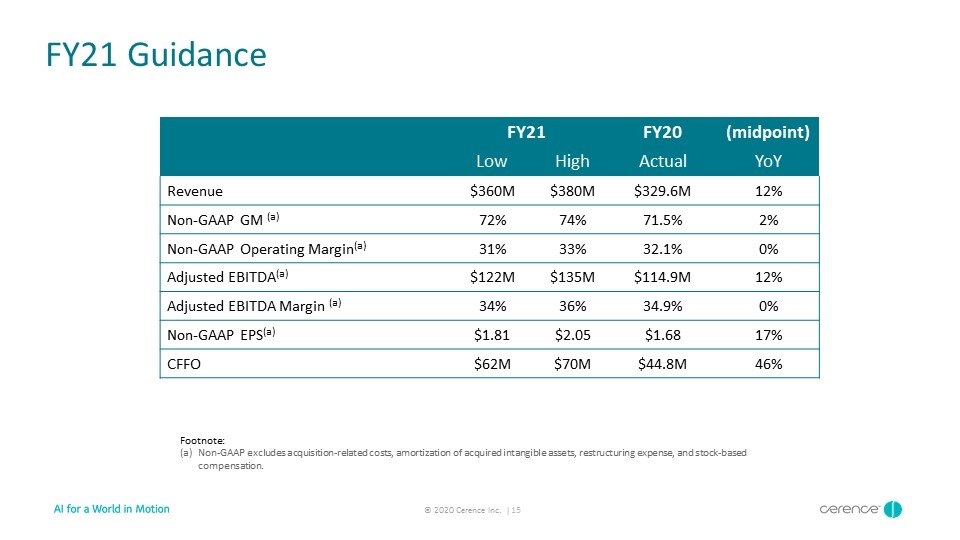
FY21 Guidance Footnote: Non-GAAP excludes acquisition-related costs, amortization of acquired intangible assets, restructuring expense, and stock-based compensation. FY21 FY20 (midpoint) Low High Actual YoY Revenue $360M $380M $329.6M 12% Non-GAAP GM (a) 72% 74% 71.5% 2% Non-GAAP Operating Margin(a) 31% 33% 32.1% 0% Adjusted EBITDA(a) $122M $135M $114.9M 12% Adjusted EBITDA Margin (a) 34% 36% 34.9% 0% Non-GAAP EPS(a) $1.81 $2.05 $1.68 17% CFFO $62M $70M $44.8M 46%

Thank You!
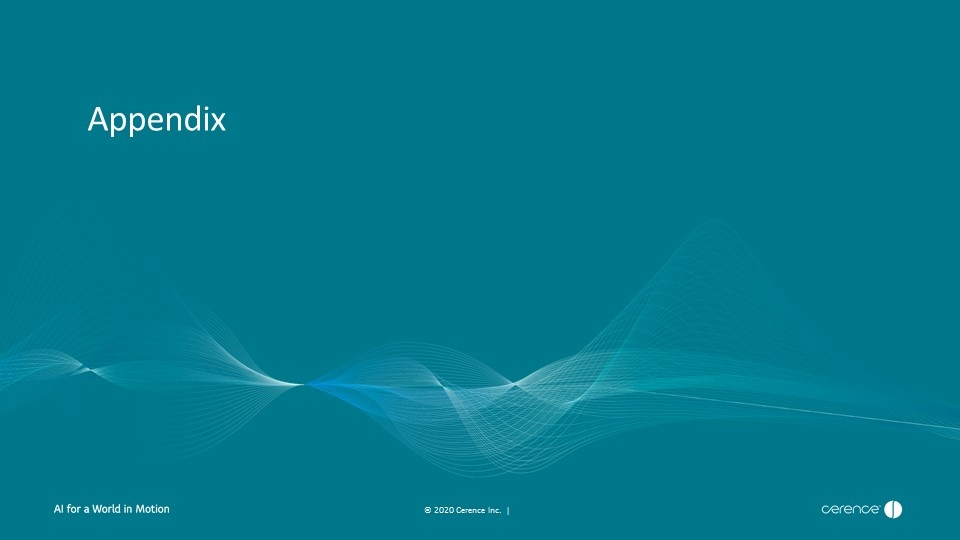
Appendix
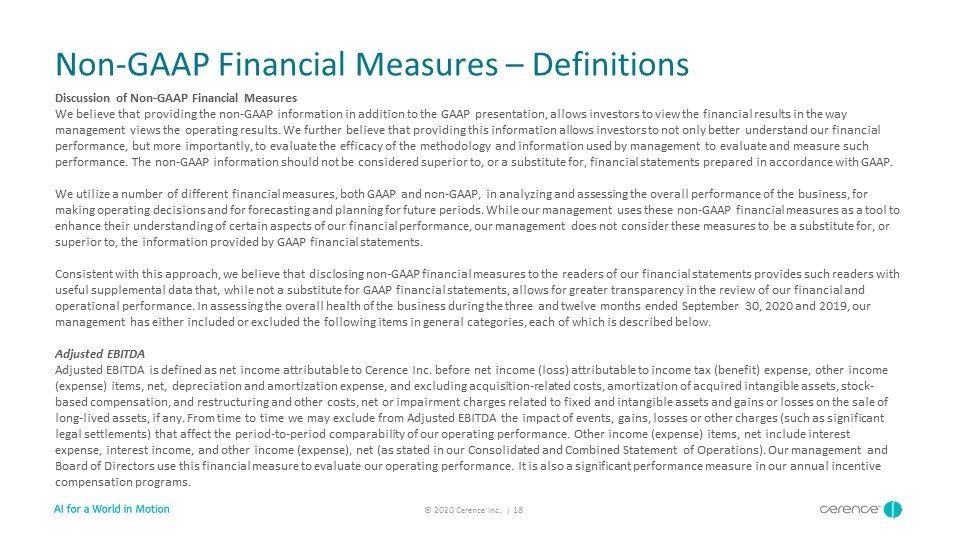
Non-GAAP Financial Measures – Definitions Discussion of Non-GAAP Financial Measures We believe that providing the non-GAAP information in addition to the GAAP presentation, allows investors to view the financial results in the way management views the operating results. We further believe that providing this information allows investors to not only better understand our financial performance, but more importantly, to evaluate the efficacy of the methodology and information used by management to evaluate and measure such performance. The non-GAAP information should not be considered superior to, or a substitute for, financial statements prepared in accordance with GAAP. We utilize a number of different financial measures, both GAAP and non-GAAP, in analyzing and assessing the overall performance of the business, for making operating decisions and for forecasting and planning for future periods. While our management uses these non-GAAP financial measures as a tool to enhance their understanding of certain aspects of our financial performance, our management does not consider these measures to be a substitute for, or superior to, the information provided by GAAP financial statements. Consistent with this approach, we believe that disclosing non-GAAP financial measures to the readers of our financial statements provides such readers with useful supplemental data that, while not a substitute for GAAP financial statements, allows for greater transparency in the review of our financial and operational performance. In assessing the overall health of the business during the three and twelve months ended September 30, 2020 and 2019, our management has either included or excluded the following items in general categories, each of which is described below. Adjusted EBITDA Adjusted EBITDA is defined as net income attributable to Cerence Inc. before net income (loss) attributable to income tax (benefit) expense, other income (expense) items, net, depreciation and amortization expense, and excluding acquisition-related costs, amortization of acquired intangible assets, stock-based compensation, and restructuring and other costs, net or impairment charges related to fixed and intangible assets and gains or losses on the sale of long-lived assets, if any. From time to time we may exclude from Adjusted EBITDA the impact of events, gains, losses or other charges (such as significant legal settlements) that affect the period-to-period comparability of our operating performance. Other income (expense) items, net include interest expense, interest income, and other income (expense), net (as stated in our Consolidated and Combined Statement of Operations). Our management and Board of Directors use this financial measure to evaluate our operating performance. It is also a significant performance measure in our annual incentive compensation programs.
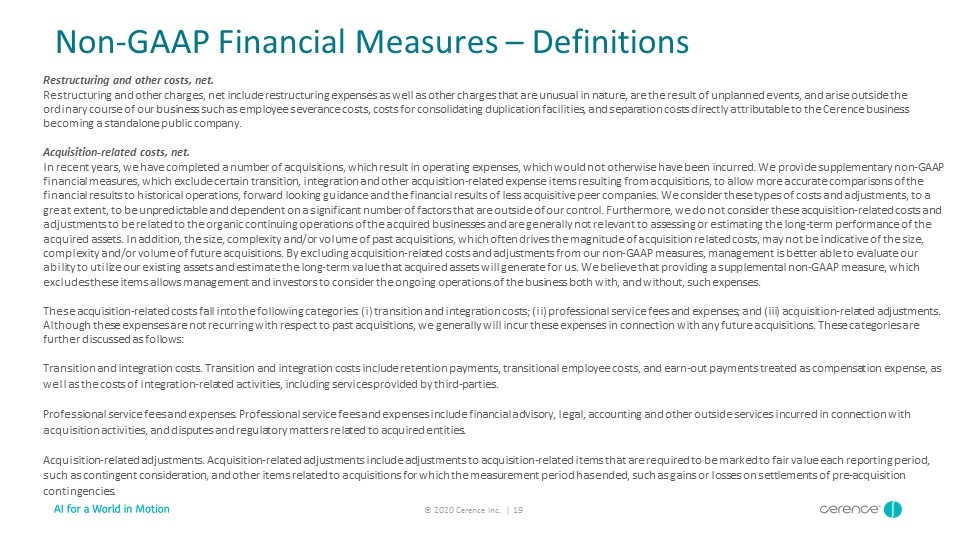
Non-GAAP Financial Measures – Definitions Restructuring and other costs, net. Restructuring and other charges, net include restructuring expenses as well as other charges that are unusual in nature, are the result of unplanned events, and arise outside the ordinary course of our business such as employee severance costs, costs for consolidating duplication facilities, and separation costs directly attributable to the Cerence business becoming a standalone public company. Acquisition-related costs, net. In recent years, we have completed a number of acquisitions, which result in operating expenses, which would not otherwise have been incurred. We provide supplementary non-GAAP financial measures, which exclude certain transition, integration and other acquisition-related expense items resulting from acquisitions, to allow more accurate comparisons of the financial results to historical operations, forward looking guidance and the financial results of less acquisitive peer companies. We consider these types of costs and adjustments, to a great extent, to be unpredictable and dependent on a significant number of factors that are outside of our control. Furthermore, we do not consider these acquisition-related costs and adjustments to be related to the organic continuing operations of the acquired businesses and are generally not relevant to assessing or estimating the long-term performance of the acquired assets. In addition, the size, complexity and/or volume of past acquisitions, which often drives the magnitude of acquisition related costs, may not be indicative of the size, complexity and/or volume of future acquisitions. By excluding acquisition-related costs and adjustments from our non-GAAP measures, management is better able to evaluate our ability to utilize our existing assets and estimate the long-term value that acquired assets will generate for us. We believe that providing a supplemental non-GAAP measure, which excludes these items allows management and investors to consider the ongoing operations of the business both with, and without, such expenses. These acquisition-related costs fall into the following categories: (i) transition and integration costs; (ii) professional service fees and expenses; and (iii) acquisition-related adjustments. Although these expenses are not recurring with respect to past acquisitions, we generally will incur these expenses in connection with any future acquisitions. These categories are further discussed as follows: Transition and integration costs. Transition and integration costs include retention payments, transitional employee costs, and earn-out payments treated as compensation expense, as well as the costs of integration-related activities, including services provided by third-parties. Professional service fees and expenses. Professional service fees and expenses include financial advisory, legal, accounting and other outside services incurred in connection with acquisition activities, and disputes and regulatory matters related to acquired entities. Acquisition-related adjustments. Acquisition-related adjustments include adjustments to acquisition-related items that are required to be marked to fair value each reporting period, such as contingent consideration, and other items related to acquisitions for which the measurement period has ended, such as gains or losses on settlements of pre-acquisition contingencies.
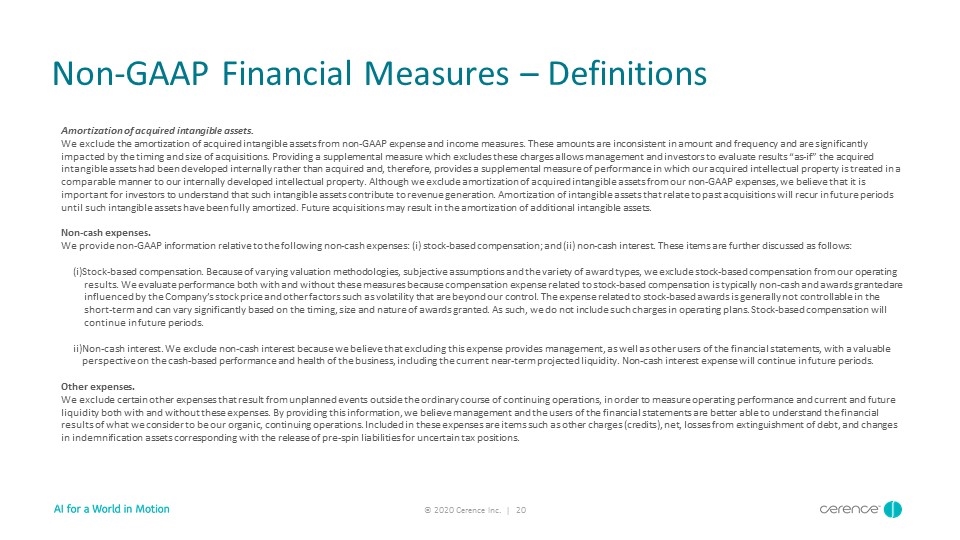
Non-GAAP Financial Measures – Definitions Amortization of acquired intangible assets. We exclude the amortization of acquired intangible assets from non-GAAP expense and income measures. These amounts are inconsistent in amount and frequency and are significantly impacted by the timing and size of acquisitions. Providing a supplemental measure which excludes these charges allows management and investors to evaluate results “as-if” the acquired intangible assets had been developed internally rather than acquired and, therefore, provides a supplemental measure of performance in which our acquired intellectual property is treated in a comparable manner to our internally developed intellectual property. Although we exclude amortization of acquired intangible assets from our non-GAAP expenses, we believe that it is important for investors to understand that such intangible assets contribute to revenue generation. Amortization of intangible assets that relate to past acquisitions will recur in future periods until such intangible assets have been fully amortized. Future acquisitions may result in the amortization of additional intangible assets. Non-cash expenses. We provide non-GAAP information relative to the following non-cash expenses: (i) stock-based compensation; and (ii) non-cash interest. These items are further discussed as follows: (i)Stock-based compensation. Because of varying valuation methodologies, subjective assumptions and the variety of award types, we exclude stock-based compensation from our operating results. We evaluate performance both with and without these measures because compensation expense related to stock-based compensation is typically non-cash and awards granted are influenced by the Company’s stock price and other factors such as volatility that are beyond our control. The expense related to stock-based awards is generally not controllable in the short-term and can vary significantly based on the timing, size and nature of awards granted. As such, we do not include such charges in operating plans. Stock-based compensation will continue in future periods. ii)Non-cash interest. We exclude non-cash interest because we believe that excluding this expense provides management, as well as other users of the financial statements, with a valuable perspective on the cash-based performance and health of the business, including the current near-term projected liquidity. Non-cash interest expense will continue in future periods. Other expenses. We exclude certain other expenses that result from unplanned events outside the ordinary course of continuing operations, in order to measure operating performance and current and future liquidity both with and without these expenses. By providing this information, we believe management and the users of the financial statements are better able to understand the financial results of what we consider to be our organic, continuing operations. Included in these expenses are items such as other charges (credits), net, losses from extinguishment of debt, and changes in indemnification assets corresponding with the release of pre-spin liabilities for uncertain tax positions.
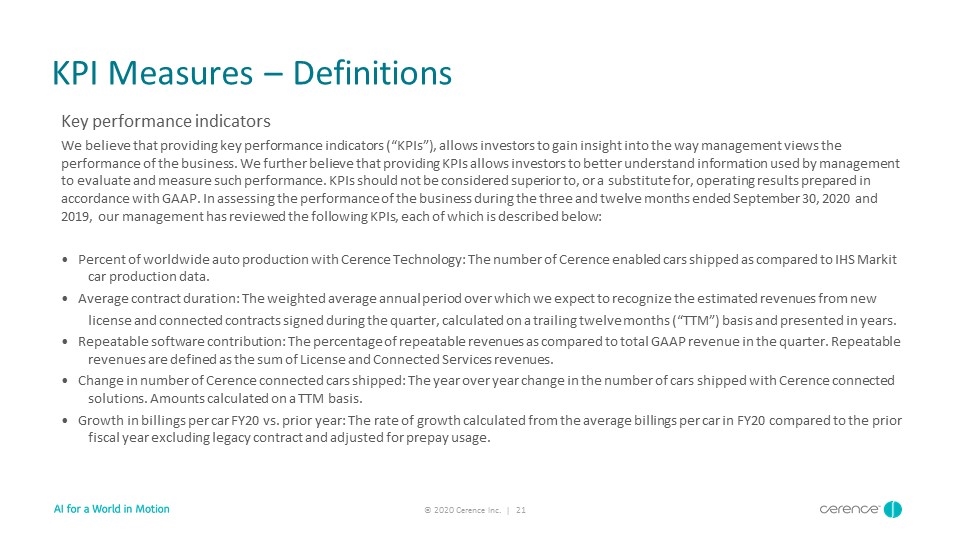
KPI Measures – Definitions Key performance indicators We believe that providing key performance indicators (“KPIs”), allows investors to gain insight into the way management views the performance of the business. We further believe that providing KPIs allows investors to better understand information used by management to evaluate and measure such performance. KPIs should not be considered superior to, or a substitute for, operating results prepared in accordance with GAAP. In assessing the performance of the business during the three and twelve months ended September 30, 2020 and 2019, our management has reviewed the following KPIs, each of which is described below: • Percent of worldwide auto production with Cerence Technology: The number of Cerence enabled cars shipped as compared to IHS Markit car production data. • Average contract duration: The weighted average annual period over which we expect to recognize the estimated revenues from new license and connected contracts signed during the quarter, calculated on a trailing twelve months (“TTM”) basis and presented in years. • Repeatable software contribution: The percentage of repeatable revenues as compared to total GAAP revenue in the quarter. Repeatable revenues are defined as the sum of License and Connected Services revenues. • Change in number of Cerence connected cars shipped: The year over year change in the number of cars shipped with Cerence connected solutions. Amounts calculated on a TTM basis. • Growth in billings per car FY20 vs. prior year: The rate of growth calculated from the average billings per car in FY20 compared to the prior fiscal year excluding legacy contract and adjusted for prepay usage.
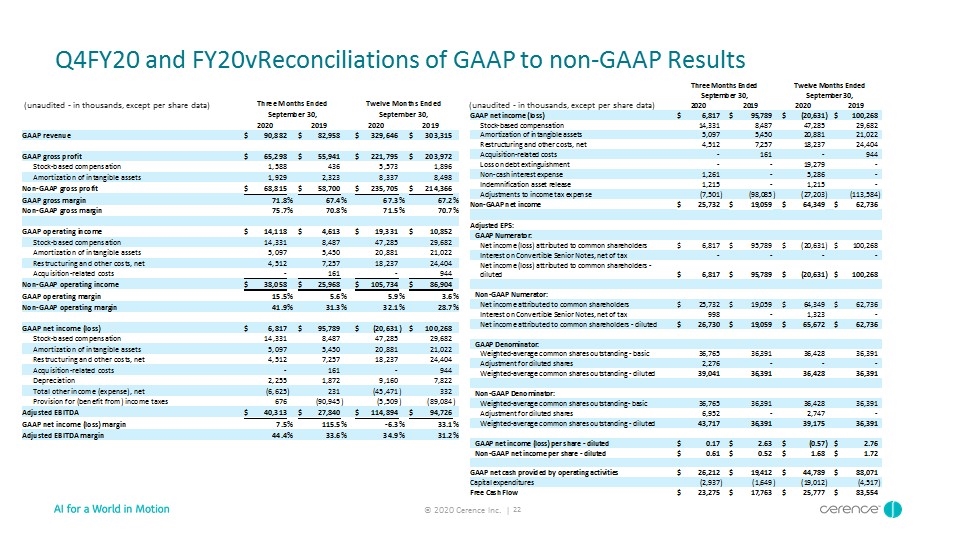
Q4FY20 and FY20vReconciliations of GAAP to non-GAAP Results (unaudited - in thousands, except per share data) (unaudited - in thousands, except per share data) CERENCE INC. Reconciliations of GAAP Financial Measures to Non-GAAP Financial Measures (unaudited - in thousands) Three Months Ended Twelve Months Ended September 30, September 30, 2020 2019 2020 2019 GAAP revenue $90,882 $82,958 $329,646 $303,315 GAAP gross profit $65,298 $55,941 $221,795 $203,972 Stock-based compensation 1,588 436 5,573 1,896 Amortization of intangible assets 1,929 2,323 8,337 8,498 Non-GAAP gross profit $68,815 $58,700 $235,705 $214,366 GAAP gross margin 71.8% 67.4% 67.3% 67.2% Non-GAAP gross margin 75.7% 70.8% 71.5% 70.7% GAAP operating income $14,118 $4,613 $19,331 $10,852 Stock-based compensation 14,331 8,487 47,285 29,682 Amortization of intangible assets 5,097 5,450 20,881 21,022 Restructuring and other costs, net 4,512 7,257 18,237 24,404 Acquisition-related costs - 161 - 944 Non-GAAP operating income $38,058 $25,968 $105,734 $86,904 GAAP operating margin 15.5% 5.6% 5.9% 3.6% Non-GAAP operating margin 41.9% 31.3% 32.1% 28.7% GAAP net income (loss) $6,817 $95,789 $(20,631) $100,268 Stock-based compensation 14,331 8,487 47,285 29,682 Amortization of intangible assets 5,097 5,450 20,881 21,022 Restructuring and other costs, net 4,512 7,257 18,237 24,404 Acquisition-related costs - 161 - 944 Depreciation 2,255 1,872 9,160 7,822 Total other income (expense), net (6,625) 231 (45,471) 332 Provision for (benefit from) income taxes 676 (90,945) (5,509) (89,084) Adjusted EBITDA $40,313 $27,840 $114,894 $94,726 GAAP net income (loss) margin 7.5% 115.5% -6.3% 33.1% Adjusted EBITDA margin 44.4% 33.6% 34.9% 31.2% CERENCE INC. Reconciliations of GAAP Financial Measures to Non-GAAP Financial Measures (unaudited - in thousands, except per share data) Three Months Ended Twelve Months Ended September 30, September 30, 2020 2019 2020 2019 GAAP net income (loss) $6,817 $95,789 $(20,631) $100,268 Stock-based compensation 14,331 8,487 47,285 29,682 Amortization of intangible assets 5,097 5,450 20,881 21,022 Restructuring and other costs, net 4,512 7,257 18,237 24,404 Acquisition-related costs - 161 - 944 Loss on debt extinguishment - - 19,279 - Non-cash interest expense 1,261 - 5,286 - Indemnification asset release 1,215 - 1,215 - Adjustments to income tax expense (7,501) (98,085) (27,203) (113,584) Non-GAAP net income $25,732 $19,059 $64,349 $62,736 Adjusted EPS: GAAP Numerator: Net income (loss) attributed to common shareholders $6,817 $95,789 $(20,631) $100,268 Interest on Convertible Senior Notes, net of tax - - - - Net income (loss) attributed to common shareholders - diluted $6,817 $95,789 $(20,631) $100,268 Non-GAAP Numerator: Net income attributed to common shareholders $25,732 $19,059 $64,349 $62,736 Interest on Convertible Senior Notes, net of tax 998 - 1,323 - Net income attributed to common shareholders - diluted $26,730 $19,059 $65,672 $62,736 GAAP Denominator: Weighted-average common shares outstanding - basic 36,765 36,391 36,428 36,391 Adjustment for diluted shares 2,276 - - - Weighted-average common shares outstanding - diluted 39,041 36,391 36,428 36,391 Non-GAAP Denominator: Weighted-average common shares outstanding- basic 36,765 36,391 36,428 36,391 Adjustment for diluted shares 6,952 - 2,747 - Weighted-average common shares outstanding - diluted 43,717 36,391 39,175 36,391 GAAP net income (loss) per share - diluted $0.17 $2.63 $(0.57) $2.76 Non-GAAP net income per share - diluted $0.61 $0.52 $1.68 $1.72 GAAP net cash provided by operating activities $26,212 $19,412 $44,789 $88,071 Capital expenditures (2,937) (1,649) (19,012) (4,517) Free Cash Flow $23,275 $17,763 $25,777 $83,554
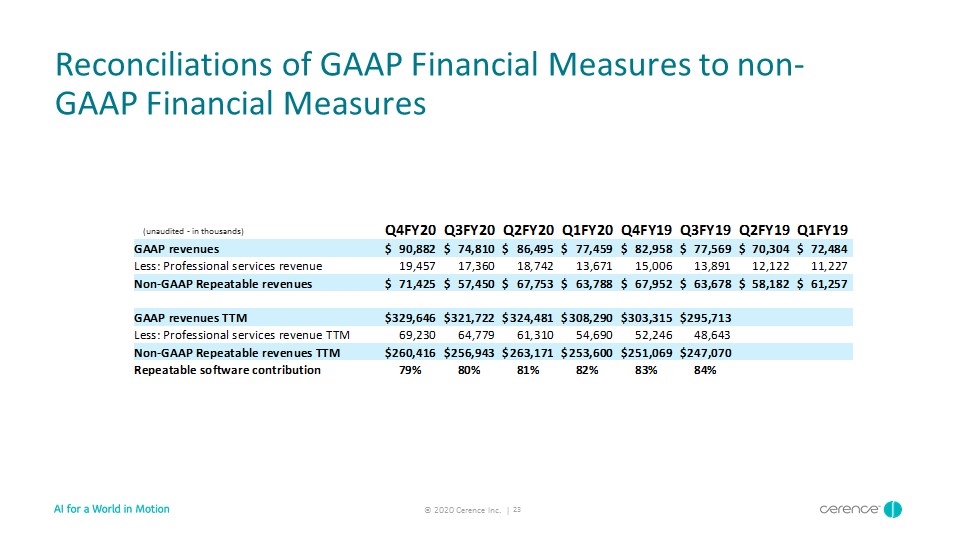
Reconciliations of GAAP Financial Measures to non-GAAP Financial Measures (unaudited - in thousands) Q4FY20 Q3FY20 Q2FY20 Q1FY20 Q4FY19 Q3FY19 Q2FY19 Q1FY19 Q4FY18 GAAP revenues $90,882 $74,810 $86,495 $77,459 $82,958 $77,569 $70,304 $72,484 $75,356 Less: Professional services revenue 19,457 17,360 18,742 13,671 15,006 13,891 12,122 11,227 11,403 Non-GAAP Repeatable revenues $71,425 $57,450 $67,753 $63,788 $67,952 $63,678 $58,182 $61,257 $63,953 GAAP revenues TTM $329,646 $321,722 $324,481 $308,290 $303,315 $295,713 Less: Professional services revenue TTM 69,230 64,779 61,310 54,690 52,246 48,643 Non-GAAP Repeatable revenues TTM $260,416 $256,943 $263,171 $253,600 $251,069 $247,070 Repeatable software contribution 79% 80% 81% 82% 83% 84%
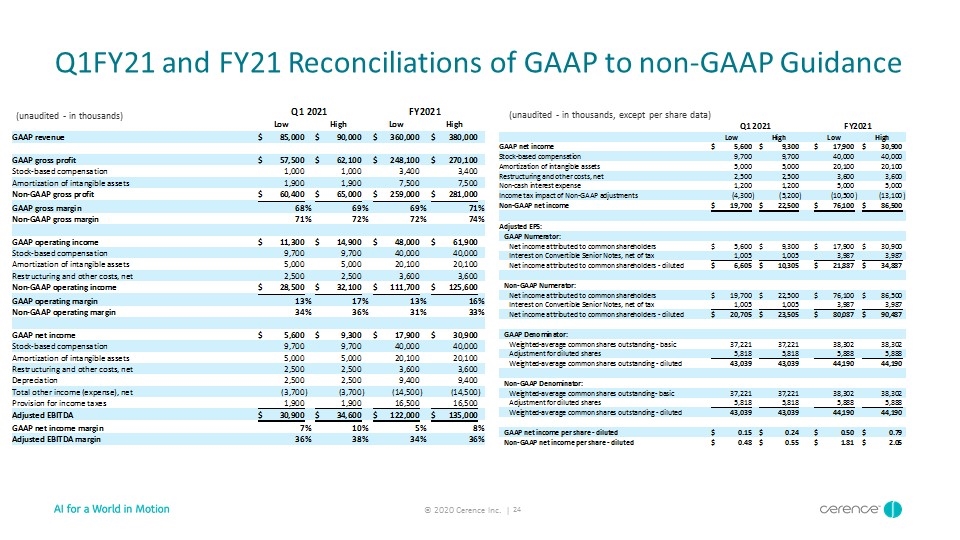
Q1FY21 and FY21 Reconciliations of GAAP to non-GAAP Guidance (unaudited - in thousands) (unaudited - in thousands, except per share data) Q1 2021 FY2021 Low High Low High GAAP revenue $85,000 $90,000 $360,000 $380,000 GAAP gross profit $57,500 $62,100 $248,100 $270,100 Stock-based compensation 1,000 1,000 3,400 3,400 Amortization of intangible assets 1,900 1,900 7,500 7,500 Non-GAAP gross profit $60,400 $65,000 $259,000 $281,000 GAAP gross margin 68% 69% 69% 71% Non-GAAP gross margin 71% 72% 72% 74% GAAP operating income $11,300 $14,900 $48,000 $61,900 Stock-based compensation 9,700 9,700 40,000 40,000 Amortization of intangible assets 5,000 5,000 20,100 20,100 Restructuring and other costs, net 2,500 2,500 3,600 3,600 Non-GAAP operating income $28,500 $32,100 $111,700 $125,600 GAAP operating margin 13% 17% 13% 16% Non-GAAP operating margin 34% 36% 31% 33% GAAP net income $5,600 $9,300 $17,900 $30,900 Stock-based compensation 9,700 9,700 40,000 40,000 Amortization of intangible assets 5,000 5,000 20,100 20,100 Restructuring and other costs, net 2,500 2,500 3,600 3,600 Depreciation 2,500 2,500 9,400 9,400 Total other income (expense), net (3,700) (3,700) (14,500) (14,500) Provision for income taxes 1,900 1,900 16,500 16,500 Adjusted EBITDA $30,900 $34,600 $122,000 $135,000 GAAP net income margin 7% 10% 5% 8% Adjusted EBITDA margin 36% 38% 34% 36% Q1 2021 FY2021 Low High Low High GAAP net income $5,600 $9,300 $17,900 $30,900 Stock-based compensation 9,700 9,700 40,000 40,000 Amortization of intangible assets 5,000 5,000 20,100 20,100 Restructuring and other costs, net 2,500 2,500 3,600 3,600 Non-cash interest expense 1,200 1,200 5,000 5,000 Income tax impact of Non-GAAP adjustments (4,300) (5,200) (10,500) (13,100) Non-GAAP net income $19,700 $22,500 $76,100 $86,500 Adjusted EPS: GAAP Numerator: Net income attributed to common shareholders $5,600 $9,300 $17,900 $30,900 Interest on Convertible Senior Notes, net of tax 1,005 1,005 3,987 3,987 Net income attributed to common shareholders - diluted $6,605 $10,305 $21,887 $34,887 Non-GAAP Numerator: Net income attributed to common shareholders $19,700 $22,500 $76,100 $86,500 Interest on Convertible Senior Notes, net of tax 1,005 1,005 3,987 3,987 Net income attributed to common shareholders - diluted $20,705 $23,505 $80,087 $90,487 GAAP Denominator: Weighted-average common shares outstanding - basic 37,221 37,221 38,302 38,302 Adjustment for diluted shares 5,818 5,818 5,888 5,888 Weighted-average common shares outstanding - diluted 43,039 43,039 44,190 44,190 Non-GAAP Denominator: Weighted-average common shares outstanding- basic 37,221 37,221 38,302 38,302 Adjustment for diluted shares 5,818 5,818 5,888 5,888 Weighted-average common shares outstanding - diluted 43,039 43,039 44,190 44,190 GAAP net income per share - diluted $0.15 $0.24 $0.50 $0.79 Non-GAAP net income per share - diluted $0.48 $0.55 $1.81 $2.05
